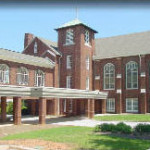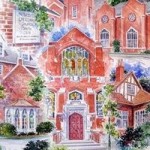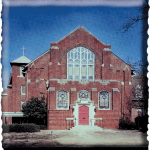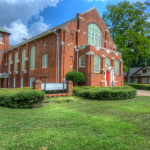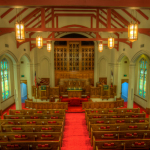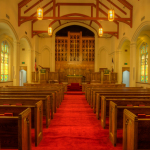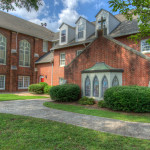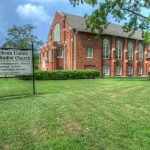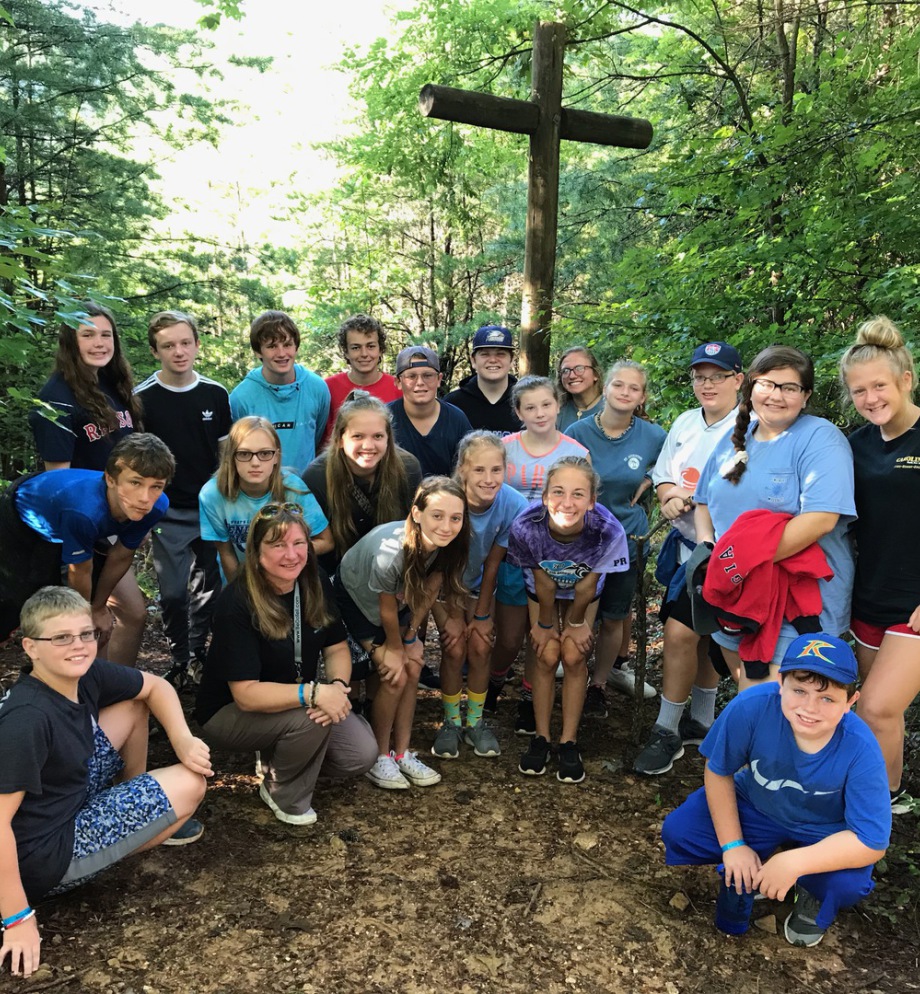
Our History
Photo Gallery
History of Jackson United Methodist Church
The Mother of Methodism in Butts County is Mary Williams Buttrill.
Mary Williams, the daughter of Burwell Williams, a wealthy merchant of Chatham County, North Carolina, was born in 1770. At the age of 17 she married William Buttrill, a Revolutionary War soldier and an aide to George Washington. At the time of her marriage, Mary was a clerk in her father’s store.
In 1817, in company with the James Harkness family, William and Mary, their ten children (seven sons and three daughters) moved to what later became Butts County, Georgia. They erected log houses for their families and their servants.
Mrs. Buttrill, a devout Christian of the Methodist faith, had a small room built in her yard for the loom on which she wove beautiful figured bedspreads. This loom house had an immense fireplace where logs were burned.
When weaving in the fall, Mrs. Buttrill had the farm bell rung at 3:30 in the afternoon to summon everyone in from the fields where they were working.
They came in, sat around the fire and ate peeled roasted potatoes while their mother read the Bible to them and prayed. Then they returned to work. Her sons often referred to the loom house as the place of their conversion. There, they said, their mother not only read and prayed with them, but shouted aloud praises to her Heavenly Master.
1818
One of Mrs. Buttrill’s first acts after arriving in Butts County was to have a special log cabin built for a meeting place. The cabin was built at the present entrance to Jackson Cemetery. For years she went to this cabin one afternoon a week taking her husband and sons, the Harkness boys, slaves and others with her. There she held the first Methodist worship service in Jackson using her Bible and prayer book. This devout Christian woman died in December, 1830 and was buried in the Old Bethel Cemetery, three miles north of Jackson.
This information was provided by her granddaughter Mary Buttrill Watson in 1925.
1826
Jackson was chartered in 1826. James Harkness, Asa Buttrill, James H. Stark and James Lyons were Judges of the Inferior Court. They laid out the town and made provisions for churches and schools. The two acres given to the Methodist Church is said to have occupied the space somewhere between the cemetery and Third Street. The church, built of logs, was called the Jackson Methodist Church.
1845
The next church site was acquired by a deed dated October 11, 1845. James H. Stark, James R. McCord, William R. Bankston, and Charles Hungerford, trustees of the Male and Female Academy, sold an acre of land, “it being the west half of the lot whereon the Female Academy now stands“, to John W. McCord, James Smith, Richard Shepard, James Brady and Thomas Lacy, trustees of the Methodist Church, for $2,000. This was witnessed by James R Lyons and J. W. Harkness.
1846
In 1846 a church building was erected on this lot at a cost of approximately $1,000. The building was typical of the age in which it was built. It faced west and had two doors, one for women on the left and one for men on the right. The usual box pulpit was about four feet from the floor with three steps leading to the entrance. Tallow candles were used until the 1880s when small lamps were substituted. On the men’s side each pew was adorned by cuspidors, which were patronized vigorously.
The following is an extract taken from an old record book of a meeting of the first Quarterly Conference held April 4, 1846:
Sunday morning Love Feast at quarter of nine. Eleven o’clock Sermon by Elder Brother Matthews which was for the dedication of our new meeting houses. After which the Sacrament of the Lord’s Supper was commemorated by the white and colored brothers and sisters.
L. Lawshe, Secty.
1848
On November 1, 1848, Augustus Cargile deeded to Charles Hungerford, “two acres in the southwest corner of town bound on the south by a road that separates it parts of the way from the public graveyard the said lot being the one on which the old Methodist Church formerly stood.”
1856
At this time, the Jackson church was on the Jackson Circuit. Tradition says that the usual compensation received by the circuit rider was dried fruit and home knit socks.
At a quarterly conference of the Jackson Circuit, on February 9, 1856, the presiding elder was the Rev. Samuel Anthony and the minister was the Rev. Morgan Bellah. At this conference a committee of four men was appointed to name the amount to pay the minister.
1859
The Bell
The bell, which bears the date 1859, first occupied the belfry of the second Methodist church. It was made by the Menleeys of West Troy, New York. The bell was transported to Griffin, Georgia by rail, then to Jackson in a wagon driven by Levi Joel Ball. The route was carefully planned to avoid wooden bridges because of the weight of the bell.
In the early days, the bell tolled every Sunday for the 11 o’clock service, for all funerals in Jackson, and for volunteer fireman when a fire was reported. It most recently tolled as part of the Day of Remembrance Service following the September 11th attack in 2001.
1870
During the late 1870s the home of William Bankston was purchased for the use of the circuit riders who made Jackson their headquarters for the Jackson circuit.
Circuit rider is a popular term referring to clergy in the earliest years of the United States who were assigned to travel around specific geographic territories to minister to settlers and organize congregations.
A "circuit" was a geographic area that encompassed two or more local churches. Pastors met each year at "Annual Conference" where their bishops would appoint them either to a new circuit or to remain at the same one. Most often they were moved to another appointment every year. (In 1804, the Methodist Episcopal General Conference decreed that no pastor was to serve the same appointment for more than two consecutive years.) Once a pastor was assigned a circuit, it was his responsibility to conduct worship and visit members of each church in his charge on a regular basis, in addition to establishing new churches. He was supervised by a Presiding Elder who would visit each charge four times a year.
Because of the distance between churches, these preachers would ride on horseback. They were popularly called circuit riders or saddlebag preachers. They traveled with few possessions, carrying only what could fit in their saddlebags. They traveled through wilderness and villages and preached every day at any place available (peoples' cabins, courthouses, fields, meeting houses, later even basements and street corners). Unlike clergy in urban areas, Methodist circuit riders were always on the move. Many circuits were so large that it would take 5 to 6 weeks to cover them. The ministerial activity of the circuit riders boosted Methodism into the largest Protestant denomination at the time. In 1784, there were 14,986 members and 83 traveling preachers. By 1839, the denomination had grown to 749,216 members served by 3,557 traveling preachers and 5,856 local preachers.
Francis Asbury (1745–1816), the founding bishop of American Methodism, established the precedent for circuit riding. Together with his driver and partner "Black Harry" Hosier, he traveled 270,000 miles and preached 16,000 sermons as he made his way up and down early America.
Possibly the most famous circuit rider was Peter Cartwright who wrote two autobiographies. John B. Matthias was an early circuit rider from New York state who is credited with having written a gospel hymn, "Palms of Victory."
Jackson United Methodist Church Pastors
Circuit Riders
1856 Morgan Bellah
1857 Jackson Rush
1858 John Murphy
1859 R. D. McWilliams
1860 P.J. Howell
1861 Alfred Dorman
1862 John W. Reynolds
1863 Morgan Bellah
1864 Alfred Dorman
1865 B.J. Johnson
1866 M.J. Leak and Samuel H. Smith
1867 J. W. Turner
1868 -1868 Davis Nolan
1869-1870 W. D. Hudson
1871 Marshall O. Malsby
1872 Robert R. Johnson
1873 No record
1874 -1875 W.T. McMichael
1875 J. Harwell
1876 -1878 A.W. Roweld
1877 Walters R. Branham, Sr. and J. W. Roberts
1878 Richard W. Rogers and R. Kedd
1879 Richard W. Rogers and A. Timmons
1880 N. Z. Glenn and C.B. Weathers
1881 N. Z. Glenn
1880
In 1880, the second Methodist church was the scene of a revival conducted by Rev. Sam P. Jones, who later became a well-known evangelist. This revival was the most far-reaching and abiding revival in the history of the church in Jackson.
1882
After the Civil War and with the completion of the East Tennessee, Virginia and Georgia Railroad through Butts County in 1882, the church began to grow and a new building was advocated for by the pastor and members. Henry F. Land, William M. Mallett, Thomas J. Dempsey, J.W. Crum, James M. Ball, Levi J. Ball, Georgia W. Mann, Dr. J.L. Mapp, Asa Buttrill, the McCord family, John B. Settle, James O. Beauchamp and others, began the building process with little cash.
1884
The construction was begun with little money and much faith in God. The cost was approximately $10,000. This third church edifice was dedicated in the fall of 1884 by Bishop Georgia F. Pierce. Jackson was soon changed from a circuit to a station church with the Reverend B.F. Farris as its first full time pastor
Station Pastors
1884-1885 B.F. Farris
1885-1886 J.B. Johnson
1886-1888 T. H. Timmons
1888-1891 Miles H. Dillard
1891-1894 James H. Eakes
1894-1895 W. T. Bell
1895-1896 Clement C. Cary
1896-1898 J. M. Bowden
1898-1900 William M. Winn
1900-1901 S.B. Ledbetter
1901-1902 R. B. O England
1902-1907 W. R. Branham
1907-1910 S. P. Wiggins
1910-1911 R. C. Checker
1911-1914 Mel S. Williams
1914-1915 A. E. Sansburn
1915-1916 Olin King
1916-1917 W. F. Foote
1917-1921 S.R. England
1821-1922 J. R. Jordan
1922-1925 Henry H. Jones
1925-1929 Augustus Ernest
1929-1930 T. M. Sullivan
1930-1932 T. E. Williams
1932-1933 Marvin R. Heflin
1933-1936 R. P. Etheridge
1936-1939 A. E. Barton
1939-1941 J. Clyde Callaway
1941-1944 E. M. Wise
1944-1948 W. S. Norton
1948-1952 Ralph C. Shea
1952-1956 P. M. Minter
1956-1960 Lamar Watkins
1960-1964 W. L. Cawthron
1964-1965 Marvin Brewer
1965-1970 J. Ray Dunahoo
1970-1974 Donald Gray
1974-1981 Phil De Moore
1981-1982 Dean Head
1982-1985 Malcolm Patterson
1985-1990 W. Mac Tribble
1990-1995 James Cantrell
1995-2000 Alice Rogers
2000-2005 C. Layne Jenkins
2005-2010 Lisa H. Derrick
2010-2014 John Brantley
2014-Present Chris Shurtz
1922
In 1922 the pastor, Reverend Henry Jones, began a crusade for a new church. During 1923 and 1924 the Building Committee was composed of H.O. Ball– Chairman, E.L. Smith-Treasurer, J.B. Settle, A.A. Howell, Hugh Mallet and R.P. Sasnett. By 1924 the new church and parsonage was erected at a cost of $65,000. The stone and brick structure was dedicated by Bishop Warren A. Candler on June 17, 1928.
The timber in the church was cut, sawed and delivered by J. E. McMichael. The large beams across the ceiling were cut from trees grown on the land owned by John B. Settle on Tussahaw Creek. The beams were so long that Mr. McMichael had to extend the coupling pole to make the wagon long enough to handle the beams. They were hauled with mule power and only two or three could be delivered at a time due to the weight and length.
The cornerstone near the entrance to the sanctuary bears the inscription, “Not forsaking the assembling of ourselves together.”
In place of the old windows, memorial stained-glass windows were installed. The cost of these eight windows was $1,575.00. The sunlight through the windows offers different colors and light depending on the time of day.
Window 1
The Open Bible
The eternal Word of God printed for us in a book. It has a lesson for every human condition. Once, the Bible was a closed Book to be read and interpreted only by the officials of the Church; now it belongs to all.
The Ten Commandments
The Ten Commandments are the foundational moral precepts for the conduct of human life. They teach us how to honor God and relate to others. They are recognized by Jews and Christians and apply to all mankind in every century.
This window was given in memory of Lulabel Dupree Moore (4.20.1878 –7.27.1911) by her children.
Window 2
The Cross and the Crown
The cross penetrates the crown, as though to say that no man is rewarded without his share of suffering. The crown completely encircles the cross, as thought to say that no man need suffer hopelessly. This symbol was dear to the early Christians, many of whom became martyrs. It provides both warning and promise. The cross says that, like our Lord, we must endure suffering and tribulation, but like Him, we shall be crowned in victory. The crown speaks of Life beyond death. “Be thou faithful unto death, and I will give thee a crown of life.” Revelation 11:10.
This window was given in memory of Sara Ball Spencer (12.9.1837—8.18.1910).
The Chalice
The chalice stands for the cup our Lord used during His last supper with His Disciples.
This window was given in memory of Martha Annie Ball (10.9.1839-10.9.1881).
Window 3
The Descending Dove
The dove is the most familiar symbol of the Holy Spirit, when Jesus was baptized in the Jordan River by John the Baptist; He came up out of the water and “He saw the heavens opened and the Spirit like a dove descending upon Him.” You will notice that the dove is beneath a cloud and is bathed in shafts of radiance called an aureole. Also, the dove carries an olive leaf in its beak. The olive branch stands for peace and healing. Jesus said to His disciples when He commissioned them to go forth in His cause, “Be ye therefore wise as serpents and harmless as doves.” Matthew 10:16 This window was given in memory of Dr. J. W. Crum (2.21.1844-6.11.1920) and Mrs. J.W. Crum (4.29.1865—12.17.1935)
The Lamb with Staff and Banner
Traditionally, the lamb was the animal of sacrifice. The lamb, though he was slain and bore the sins of many, stands in a posture of victory and carries a staff from which there floats the resurrection banner, marked with a gold cross. The white resurrection banner signals victory that has emerged from suffering and death.
Given in memory of Eva Sasnett (4.30.1850-8.10.1909).
Window 4
The Hand with the Uplifted Torch
Every person needs a light for his guidance. The hand shows strength and purpose, and the inscription reads, “The Lord is my Light.” Psalm 27:1 reads “the Lord is my light and my salvation, whom shall I Fear? The Lord is the strength of my life; of whom shall I be afraid?” God dispels darkness. In the radiance of his company, we are furnished all the light we need.
This window was given in memory of Mrs. Mary Williams Buttrill– Mother of Methodism in Butts County –1818-1830—The Lord is Light
The Harp
The harp is a reminder of the music of David in particular, of joy in our worship and of the coming joy of Heaven. The Christian religion inspires song. Jesus and His disciples sang a hymn before He went into the Garden of Gethsemane. At midnight, and in prison, Paul and Silas prayed and sang praises. Wherever the Christian faith has gone, it has caused us to sing.
Given in memory of Asa Buttrill (6.27.1810– 4.25.1893)
Window 5
The Crown
The crown has a two-fold message. It says that Jesus of Nazareth, born in lowly circumstances, is crowned Lord and King. He has the status that no other man has attained. It is His alone. He is crowned in divine royalty; however, the crown is promised to every faithful Christian. In II Timothy 15:8, Paul spoke of a crown of righteousness which he and all who love Christ would receive. Given in memory of Martha Emma Mallet (12.7.1860—5.28.1938)
The Anchor
The anchor is one of the most ancient of Christian symbols and stands for the hope that we have in Christ. A hope that makes on steadfast. The Scripture from which this symbol is derived is Hebrews 6:18-19, which speaks of “the hope set before us which hope we have as an anchor of the soul, both sure and steadfast.” The anchor once held for persecuted Christians the disguised image of the cross. The two symbols have been combined, and one can see the trace of the cross in this window. Given in memory of William Maurice Mallet (3.12.1845-12.15.1900).
Window 6
The Sheaf of Wheat
The Sheaf of Wheat compliments the companion window and suggests the bread which is served in holy communion to represent the Body of Christ. This wheat stands for bread, which is the staff of life. Jesus himself taught us to pray for daily bread. The wheat standing on the fertile field reminds us of God’s unfailing goodness in providing for our physical needs. Through the rhythm of the season the good earth brings forth her harvest.
Given in memory of Sara Stilwell Ball (1.29.1847—1.11.1925)
Cluster of Grapes with Stem and Leaves
Grapes bear the juice of wine, which represents the blood of Christ, shed for us. It provides one of the elements through which we commune with Christ on holy occasions. Also, we are reminded that Christ is the true vine and we are the branches.
Given in memory of Levi Joel Ball (7.17.1844– 10.14.1903)
Window 7
Easter Lilies and Lamp on the Bible
This lovely flower blooms at Easter and is symbolic of Christ's resurrection. The bulb dies in the cold, dark earth and from its decay and death there springs forth another bulb, stem, leaves and bloom. That very life cycle predicts that though the outward man perishes, the believing soul is raised to new and glorious life in Christ.
The Lamp
It is, of course, an ancient lamp. Through the ages, the lamp has been a token of light, intelligence, learning and fervor of faith. It is fitting that man’s intelligence rests on the Book of Books. “Thy word is a lamp unto my feet and a light unto my path.” Psalm 119:10
Given in memory of Ida Estella Thornton (12.5.1887—4.27.1920)
Window 8
Alpha and Omega
Alpha and Omega, represented in this window are the first and last letters of the Greek alphabet. They stand for Jesus Christ, who described His role through the inspired Revelator; “I am Alpha and Omega, the beginning and the end, the first and the last.” In other words, He is everything.
Given in memory of James Marshall Finely (2.1.1841– 4.20.1922)
Palm Branches in Crown
This signifies victory. Palm branches were strewn in the path of royalty. The symbol quite readily suggests to us Christ’s triumphal entry in Jerusalem during His last week on earth-the event which is commemorated on Palm Sunday. We remember that the King of Kings was crowned, ironically, with a wreath of thorns in crude mockery.
Given in memory of James William Finely (11.14.1887—7.24.1918) Killed in France at the Battle of Marne during World War I.
1940s
The Organ
On October 24, 1946, the church signed a contract with Austin Organs, Inc. to build and erect an organ for $6256. The organ was to be delivered by April 24, 1948. In January 1949, Austin Organs, Inc. sent correspondence to the church stating “we have been plagued with shortages which have seriously curtailed our manufacturing program”. Due to increased manufacturing and labor costs and in order to deliver the organ in the fall of 1949, the cost was increased to $7800, which the church accepted. The organ was delivered in August, 1949 and erected by Mr. Roy E. Staples of Austin Organs. American Seating Company provided the case work to accommodate 28 seats for the choir, organ screen and paneling at a cost of $3220.00. Wilfred L. Keel was the architect. Mr. T. E. Robinson was elected chairman of the organ committee and an organ fund was created. Between October 1946 and October 1949 over 200 members gave $14,867.12, ranging from $1 to $4000, with the average gift being $50. A beautiful communion table was given by Mrs. John Battle Settle. On Sunday, October 9, 1949, the dedication service of the majestic pipe organ with chimes was held at the 11am worship service.
1950’s-1960’s
The Men’s Club was organized in 1955.
In 1959, the sanctuary was renovated. The ceilings were painted, the plaster was repaired, the pews were re-varnished and the stained-glass windows were strengthened. Improvements were also made on the parsonage.
During the sixties, both the parsonage and the church were air conditioned.
1970’s
A major renovation of the church exterior, sanctuary and fellowship hall was undertaken in 1972-1974. The front of the sanctuary was enclosed and the large stained glass window was installed over the balcony.
The church annex which was located on the west side of McKibben Street was purchased in 1973. For many years, it served as the church office, nursery, and church school space.
In 1979 a new parsonage was built on Briarcliff Road. Prior to this the pastor and family lived in the parsonage on the church grounds
Church Entrance
In 1974 the large window over the church entrance, at the back of the sanctuary in the balcony, was placed in honor of the Building Committee, builders and architects.
The lesser windows remind one of the symbols emblazoned on the shields of the Crusaders. As such, they would provide the marking of identity and means of protection, as the Church invades an indifferent and possibly hostile world.
The major symbols are four and represent the Four Apostles—Matthew, Mark, Luke and John. There are two other scripture references to these images. In a vision, Ezekiel had this impression: “As for the likeness of their faces, they four had the face of a man and the face of a lion on the right side; and they four had the face of an ox on the left side; they four also had the face of an eagle.” Ezekiel 1:10.
Beginning on the left—
Window 1
Matthew is often pictured as a winged man. His Gospel is felt to stress the human side of the life of Jesus. Sometimes Matthew is pictured with a pen or book in his hand and possibly with the assistance of a nearby angel.
Given in honor of the Building Committee Members– J.B. Settle, Hugh Mallet, R. P. Sasnett ; A.A. Howell. Architect: T. J. Brodie. Builder G.L. Maddox
Church Entrance
Window 2
Mark is represented by the winged lion. The lion stands for the kingly character of Christ. Also, very early in this book, Mark tells about “the voice of one crying in the wilderness.”
Given in honor of Pastor H.H. Jones, and Building Committee: H.O. Ball, Chairman and E.L. Smith., Treasurer
Window 3
Luke has the winged ox for his symbol. His Gospel opens upon the sacrifice made by Zacharias in the temple. Zacharias was a priest and the father of John the Baptist. Later in his Gospel, Luke underscores the sacrificial nature of the death of Jesus Christ.
Given in honor of the Church Remodel 1972-1974 Pastor: W. Donald Gray, Architects: Bothwell, Jenkins & Slay, Builders: J. H. Campbell Co.
Window 4
John is symbolized by the eagle. His has been called “the spiritual gospel.” It soars in inspiration and lifts the reader to the throne of God’s Grace.
Given in honor of Building Committee: Levi J. Ball Chairman, Bailey M. Crockarell, Mrs. Helen M. Ham, Denis A. O’Neal and Mrs. Beatrice M. Briscoe
Entry—Stairwell to the Balcony
On the right stairwell, the first window is the symbol of the Holy Bible.
Given in memory of Lois J. Coleman (6.17.1905– 4.17.1988)
The second window is the symbol of the harp.
Given by the J.B. Sams family
On the left stairwell, the first window is the symbol of the cross, Bible and anchor.
Given in memory of Lois J. Coleman (6.17.1905– 4.17.1988)
The second window is the symbol of the lilies.
Given in honor of Ruth Tribble Conner
Narthex
The beautiful window over the door is the lamp and bible.
Given in memory Virginia Coffee Tribble
To the left side of the door is Noah’s Ark.
Given in memory Col. W. B. Mc Coy
To the right side of the door is the descending dove.
Given in honor of Tom Carmichael
To the wall on the right is the bible and cross.
Given in memory Julia Bolton Fletcher (11.9.1912– 3.1.1993)
The small bronze plaque by the door inscribed “You Light Up My Life” is given for the lights outside the main door.
Given to honor Mary Mallett Carr by her husband Ralph and their daughters Lane, Lucia, Emily and Kibbie
The Parsonage
The history of our parsonages is rich and interesting. The current parsonage on Briarcliff Road was built in 1979. The beginnings date back to the late 1870s when the home of Mr. William R. Bankston was purchased for the use of the Circuit Riders who made Jackson headquarters.
Because of the distance from the church, this home was sold to Mr. E. C. Robison and a new wooden parsonage was built when the third church was erected in 1884. Lella Jackson Dillard, the second child of Miles and Lella Dillard, was born in this parsonage on December 15, 1889. Twenty-one pastors over the next 40 years lived in this parsonage.
The next parsonage was built in 1924 when the church was built. The beautiful front parlor was used for weddings while the family lived in the rest of the house. For the next 55 years, 17 pastors and their families called this parsonage home.
In 1979 the current parsonage was built. For the last 39 years, 17 pastors and their families have lived in this location. The parsonage has had several updates. The first occurred in the late 1990s with the kitchen cabinets being painted and the kitchen, breakfast room and laundry room floors replaced.
In 2017, a major renovation of the family room, kitchen and breakfast room was completed by combining them into one large room for an open concept with all new cabinets, granite countertops, hardwood flooring and appliances. A unique feature of the new wood flooring is the fact that it is the same type of wood used by Noah in the building of the ark.
1980’s
In the 1980s, in response to a need for more and improved space for an elevator, chapel, children and youth offices and other church activities, another building program was undertaken. An East wing was completed in 1986, blending so well that is seems to have been part of the earlier building. The new wing included a library, a chapel with memorial windows and the church offices. New memorial stained-glass windows were added to the entry hall in 1988.
In our lovely chapel you can find peace as you reflect on its windows. There are five windows across the front and one on each side.
Facing the front and beginning at the left is the harp. Given in memory of Albert and Kate Finley
Next is the lilies.
Given by Levi and Nora Ball
Next is the crown and cross.
Given in honor of Mr. and Mrs. Weymon, J. Fortson and Mrs. and Mrs. John W . Holliday, Sr.
Next is faith, hope and charity.
Given in memory of Lamar Jinks and Eugene Parrish
Next is grapes, the leaves and vine.
Given in memory of Rolfe and Ruth Burford
On the left window is wheat and the inscription “I am the Bread of Life.”
Given in honor of Bailey, Sara Beth, Morris, Kathy and Alan Crockarell
On the right window is the dove.
Given in memory of Maurice and Lucy Moore
1990
In 1990 the church underwent major changes. The old wooden annex located across McKibben Street was torn down and a new parking area was added in 1997. The Thanksgiving Meal project started in 1997.
2000s
At the beginning of the twenty-first century and as part of a rapidly growing city and county, we expanded our outreach with another impressive building.
A new fellowship hall was added in 2000-2001. The fellowship hall also has beautiful round stained glass windows.
The larger window in the center was given in honor of Larry and Lucia Fletcher. The Bridge is in honor of Elizabeth Leigh Fortson and Chandler Alexandra Fortson.
Windows on the Bridge
In memory of Ben and Molly Garland given by Byrd and Tyler Garland and family.
In memory of Martha Watts Harris given by Byrd and Tyler Garland and family.
In memory of Hugh and Mary Lane Mallet.
In memory of David and Thelma Settle.
In memory of Smith and Ruth Settle.
In honor of Elizabeth Whitney Fears, Emily Andrews Fears and Alfred Daniel Fears, III.
In memory of Ace and Nellie Maddox.
In memory of Robert and Liva Mohr and Lawrence and Carolyn Morgan given by Larry, Kathy, Mary Beth and Katie.
In memory of John W. Holliday, Sr. and in honor of Miriam T. Holliday given by Keith, Gay, Elizabeth and Chandler Fortson.
In honor of our families given by Larry, Lucia, Sybil and Jenny Fletcher.
To the glory of God and in honor of the visionary members of
Jackson United Methodist Church given by the Reverend Dr. P. Alice Rogers.
In memory of Weymon J. Fortson and in honor of Margaret D. Fortson given by Keith, Gay, Elizabeth and Chandler Fortson.
In memory of Ruth Smith Watkins January 20, 1912 –September 24, 1997.
In memory of Lem Watkins April 19, 1904-August 13, 1997.
In 2001 the Mary Buttrill School was founded with 29 students. This school provided quality educational programs both spiritually and academically from 3K-3rd grades. Elisa A. Reece served as principal.
In 2003 the church raised $14,000.00 to update the sound system in the sanctuary.
In 2005, the grand piano that is in the fellowship hall was donated by Herman and Nancy Waits for use in the Gathering Room and Fellowship Hall.
In 2005, a project was started to replace the cushions in the sanctuary. It was a $7,000.00 project.
In 2005, several repairs were made on the parsonage before Pastor Lisa Derrick arrived. Lane and Diane Jenkins moved out of the parsonage on June 1 to allow the repairs to be done before the Derricks arrived on June 23, 2005.
In 2005, October 30- November 5, JUMC sent a mission team to Ocean Springs, MS to help with the Katrina clean up. They worked with the UMCOR team in that area.
In 2005, the Parish House was remodeled for office space for the pastor and staff. All the work on the Parish House was done by donations from members and by the member’s hands. In 2005, discussion began about starting a contemporary service.
On December 4, 2005, we recommended Jennifer Fletcher Anderson and Will Zant for ministry.
The first contemporary service was held on June 25, 2006, at 9:00 am in the Fellowship Hall. Gordon Respess played a large part in starting the service and overseeing the music and musicians for the service. Gordon led the worship in this service for ten years. In 2016, Theresa Hobbs became the worship leader. The purpose of the service was to bring a casual, come-as-you-are feel to the service with contemporary music to attract more attendance.
In 2006, a mission trip to Honduras was planned.
In 2006, the renovation of the organ began. The renovation was done by A.E. Schlueter Pipe Organ Co. The project cost a total of $178,045. The complete renovation took twelve months.
In 2007, we had three overseas mission trips. We started helping with the mission project, “Meals on Wheels”. We offered our first Alpha class. The church purchased two properties. The first, at 307 Third Street, was purchased from Tom Webb for $350,000.00. We also purchased the property next to the Webb house, 327 East Third Street, from Dan Fears. This building served as the church office for a few years.
In 2008 the Community Involvement Team was formed. Out of this mission came the Let’s Wrap Program that gives a new coat to elementary students every year.
In 2008, the Trustees and the Administrative Council approved the use of the Webb house for the CERF (Christian Emergency Relief Foundation) House. This organization addresses the needs of Butts County residents and helps with housing, utilities, medicine, food and clothes.
2010-2020
In 2015, the church restored the main stained glass windows and replaced the worn yellow plexiglass covers with new clear plate glass covers so that the windows could be seen from the outside and enjoyed by everyone again.
In 2016 we hosted a Retired Educators Day. On November 13, 2016 we held a dedication for the new flagpole. We adopted McDonough Road to keep it clean of litter. We collected 1,426 glue sticks for the school children of Butts County. Certified Yoga Instructor and member, Lina Haag, taught Chair Yoga classes. The Youth went to San Francisco, California on a Mission Trip. The Men’s Club held a Pancake Breakfast with all of the proceeds going directly to the Youth. We adopted our Just You Me & Christ logo. In December of 2016 the Youth presented “Robin & His Jolly Men” play during dinner.
In 2017 we began the year hosting a church-wide retreat. In May we held a National Day of Prayer service. In June we hosted Vacation Bible School. The Pumpkin Patch returned and we sold over $7,000 worth of pumpkins. All of the profits were donated to St. Jude Children’s Hospital. From unloading in the rain, to manning the patch, to visiting with the community, everyone enjoyed working together. The Youth held their annual yard sale to support their mission work. Before the cold weather hit in 2017, the Let’s Wrap program gave out coats to elementary students in Jackson who needed them. The Men’s Club held a successful Boston Butt’s fundraiser. We had a booth at the Jackson Alive festival. We held a Community Men’s Prayer breakfast in the fellowship hall. We had another successful Thanksgiving mission by delivering meals to many of the Jackson community. In December the Chancel Choir performed a cantata, “Sing Joy to All the World”. The children presented a Christmas pageant and the youth performed in a Christmas play.
2018-Our Bicentennial Year
Jackson United Methodist Church was founded in 1818. In the year 2018, we proudly celebrated our bicentennial. We began the year as a church of 410 members. We started off the year with a Parsonage Open House. The Garlands hosted a party for the children, youth and their families at their home. On February 2, we held a planning retreat where we formed a committee to plan our Bicentennial celebration. The following activities were enjoyed by the congregation:
On March 12, 2018, the Butts County Government presented a proclamation to the church celebrating its 200th anniversary.
The Bicentennial Committee created a cookbook filled with member’s recipes and the 200-year history of our church.
On July 22 we hosted the opening of the 1818-2018 Bicentennial Celebration with a display of our church history. We also sold magnets with the Bicentennial Celebration logo.
On July 29 we hosted a dinner for the Barte Family who shared their missionary experience.
On August 12 we welcomed back Rev. Jim Cantrell who served as Jackson UMC pastor from 1990-1995. He was our guest pastor for the day.
On August 25 we hosted the Bicentennial Celebration Car Show and Family Festival on the church grounds.
September 9 was Mary Buttrill Sunday and Lucia Fletcher served as Mary Buttrill for the day.
On September 16, Homecoming Sunday, we welcomed back Rev. Phil DeMore who served as Jackson UMC pastor from 1974-1981. He was our guest pastor for the day.
On September 21 we hosted an evening of fun in the fellowship hall featuring Christian comedian Scott Davis and Matt Duren as they presented the Fantastic Friday Comedy Show.
On September 30 we enjoyed a Wesley Camp Meeting as pastor Chris Schurtz rode in on horseback like a Circuit Rider. The congregation gathered under the trees on the lawn as he delivered a Wesley sermon.
On October 21 we welcomed back Rev. Alice Rogers who served as Jackson UMC pastor from 1995-2000. She was our guest pastor for the day.
Other activities in 2018 included a Relay for Life dinner in March and our second annual National Day of Prayer in May. The Youth went on a mission trip to North Carolina in June and hosted a Youth Sunday at our church. We also had a very successful Vacation Bible School with the theme Rolling River Rampage.
In 2019, we held our second annual Car Show. The Men’s club contributed by cooking hamburgers and hot dogs for lunch. The Mission Committee continued their support of many projects including Smart Lunch, Smart Kids, Weekly Back Pack meals, CERF, Meals on Wheels, Relay for Life and Summer Back Packs. The Youth held their annual yard sale to support their mission projects.
Youth Department:
Seniors had their senior trip in February and they saw parts of the Bahamas. We performed a play about coming to Jesus that used some music from the band Imagine Dragons. We walked the dogs at the Butts County Animal Shelter. We had our senior worship service. 6 people graduated. We went on mission trip in New York City where we worked in a soup kitchen and saw many tourist spots as well as touring the Jewish Heritage Memorial Museum. We helped monitor the children during VBS, had a couple of lock-ins, played basketball, and had a game night over the summer. The new MYF school year started August 14th. We r getting ready for our yardsale. On Sundays we prayer at Burger King, have bible study, sing praise songs, and pray in the prayer room.
We currently offer two services on Sunday, five Sunday School classes, youth group, children’s ministry, choir, band, Wednesday night dinners, men’s club, small groups and mission work opportunities. Over the years, we have held over 6 ALPHA courses with over 60 people attending.
